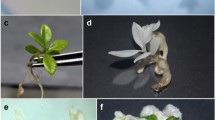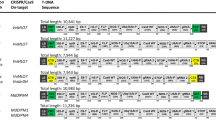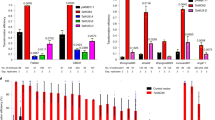Abstract
A disarmed derivative of the Ti:R772 cointegrate plasmid pAL969 was used to produce transgenic plants of a commercially important inbred line of oil–producing sunflower. A chimeric gene (neo) composed of the coding sequence of neomycin phosphotransferase (NPT) and 5′ and 3′ sequences from octopine synthase permitted the selection of kanamycin–resistant (Kanr) callus capable of plant regeneration. Kanamycin inhibited plant regeneration, precluding simultaneous plant regeneration and selection for resistance to the antibiotic. Progeny analysis of transformed seedlings indicated Mendelian inheritance of neo. Expression of neo in transformed seedlings and plants indicated that the use of a Ti–derived promoter does not guarantee constitutive expression of the foreign gene. These results demonstrate that the introduction of foreign genes via Agrobacterium–mediated transformation can now be used for agronomic improvement of sunflower.
This is a preview of subscription content, access via your institution
Access options
Subscribe to this journal
Receive 12 print issues and online access
$209.00 per year
only $17.42 per issue
Buy this article
- Purchase on Springer Link
- Instant access to full article PDF
Prices may be subject to local taxes which are calculated during checkout
Similar content being viewed by others
References
Putt, E.D. 1978. History and present world status, p. 1–29. In: Sunflower Science and Technology. Agronomy 19. J. F. Carter (ed.), American Society of Agronomy.
Murai, N., et al. 1983. Phaseolin gene from bean is expressed after transfer via tumor-inducing plasmid vectors. Science 222: 476–482.
Matzke, M.A. et al. 1984. Transcription of a zein gene introduced into sunflower using a Ti plasmid vector. EMBO J. 3: 1525–1531.
Goldsbrough, P.B., Gelvin, S.B. and Larkins, B.A. 1986. Expression of maize genes in transformed sunflower cells. Mol. Gen. Genet. 202: 374–381.
Horsch, R.B., et al. 1985. A simple and general method for transferring genes into plants. Science 227: 1229–1231.
Paterson, K.E. and Everett, N.P. 1985. Regeneration of Helianthus annuus inbred plants from callus. Plant Science 42: 125–132.
Paterson, K.E. 1984. Shoot tip culture of Helianthus annuus-flowering and development of adventitious and multiple shoots. Amer. J. Bot. 71: 925–931.
Otten, L., et al. 1981. Mendelian transmission of genes introduced into plants by the Ti plasmids of Agrobacterium tumefaciens. Mol. Gen. Genet. 183: 209–213.
De Block, M., et al. 1984. Expression of foreign genes in regenerated plants and in their progeny. EMBO J. 3: 1681–1689.
Jones, J.D.J., Dunsmuir, P. and Bedbrook, J. 1985. High level expression of introduced chimaeric genes in regenerated transformed plants. EMBO J. 4: 2411–2418.
An, G. 1986. Development of plant promoter expression vectors and their use of analysis of differential activity of nopaline synthase promoter in transformed tobacco cells. Plant Physiol. 81: 86–91.
De Greve, H., et al. 1982. Regeneration of normal and fertile plants that express octopine synthase, from tobacco crown galls after deletion of tumour-controlling functions. Nature 300: 752–755.
Lacy, E., et al. 1983. A foreign α-globin gene in transgenic mice: Integration at abnormal chromosomal positions and expression in inappropriate tissues. Cell 34: 343–358.
Hazelrigg, T., Levis, R. and Rubin, G.M. 1984. Transformation of white locus DNA in drosophila: dosage compensation, zeste interaction, and position effects. Cell 36: 469–481.
Fluhr, R., et al. 1986. Organ-specific and light-induced expression of plant genes. Science 232: 1106–1112.
Ooms, G., Twell, D., Bossen, M.E., et al. 1986. Developmental regulation of RI TL-DNA gene expression in roots, shoots and tubers of transformed potato (Solanum tuberosum cv. Desiree). Plant Mol. Biol. 6: 321–330.
Koncz, C. and Schell, J. 1986. The promoter of TL-DNA gene 5 controls the tissue-specific expression of chimaeric genes carried by a novel type of Agrobacterium binary vector. Mol. Gen. Genet. 204: 383– 396.
Lloyd, A.M., et al. 1986. Transformation of Arabidopsis thaliana with Agrobacterium tumefaciens. Science 234: 464–466.
Hille, J. et al. 1983. Site-directed mutagenesis in E. coli of a stable R772:Ti cointegrate plasmid from A. tumefaciens. J. Bacteriol. 154: 693–701.
Reiss, B., et al. 1984. A new sensitive method for qualitative and quantitative assay of neomycin phosphotransferase in crude cell extracts. Gene 30: 211–218.
Author information
Authors and Affiliations
Rights and permissions
About this article
Cite this article
Everett, N., Robinson, K. & Mascarenhas, D. Genetic Engineering of Sunflower (Helianthus Annuus L.). Nat Biotechnol 5, 1201–1204 (1987). https://doi.org/10.1038/nbt1187-1201
Received:
Accepted:
Issue Date:
DOI: https://doi.org/10.1038/nbt1187-1201
This article is cited by
-
Composite plants for a composite plant: an efficient protocol for root studies in the sunflower using composite plants approach
Plant Cell, Tissue and Organ Culture (PCTOC) (2020)
-
Low Agrobacterium tumefaciens inoculum levels and a long co-culture period lead to reduced plant defense responses and increase transgenic shoot production of sunflower (Helianthus annuus L.)
In Vitro Cellular & Developmental Biology - Plant (2016)
-
Agrobacterium-mediated transformation of cotyledons of mature seeds of multiple genotypes of sunflower (Helianthus annuus L.)
Plant Cell, Tissue and Organ Culture (PCTOC) (2012)
-
Generation of white mold disease-resistant sunflower plants expressing human lysozyme gene
Biologia plantarum (2006)
-
Dehydrating immature embryo split apices and rehydrating withAgrobacterium tumefaciens: A new method for genetically transforming recalcitrant sunflower
Plant Molecular Biology Reporter (2002)



